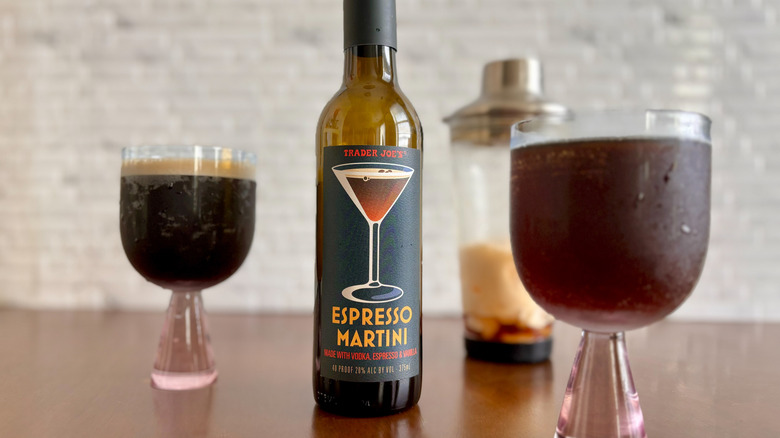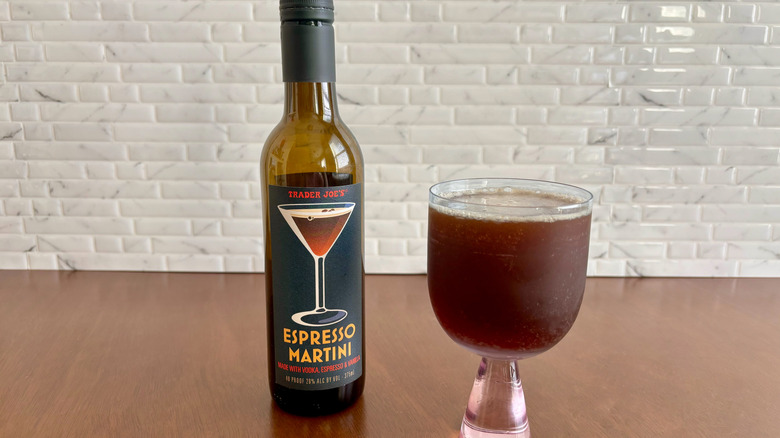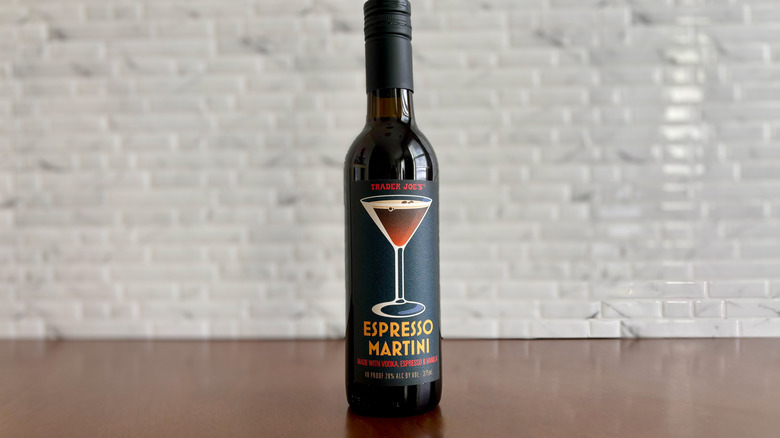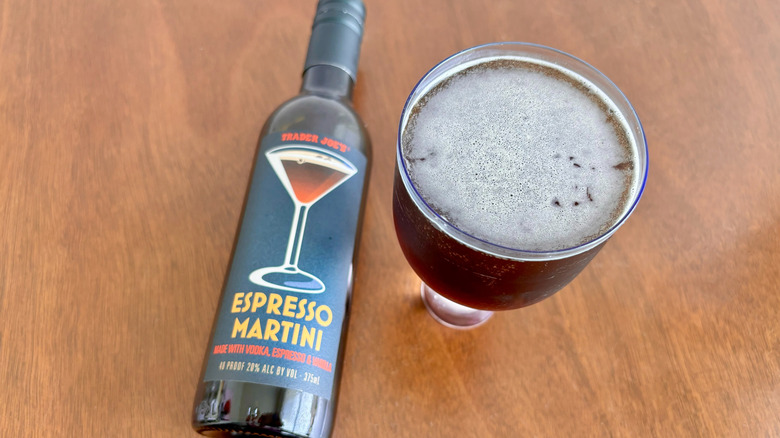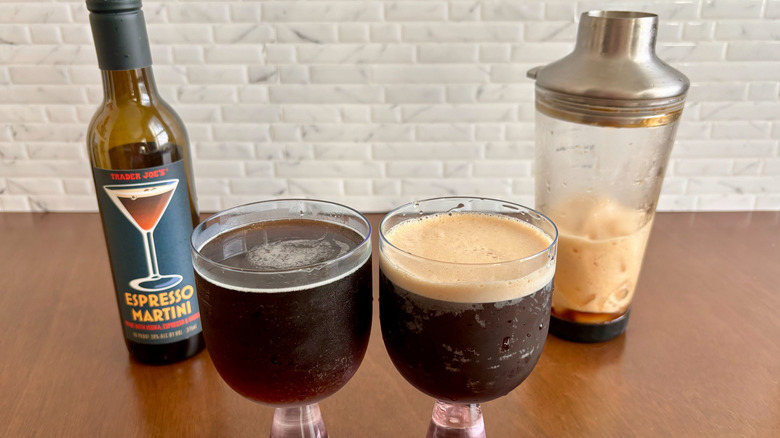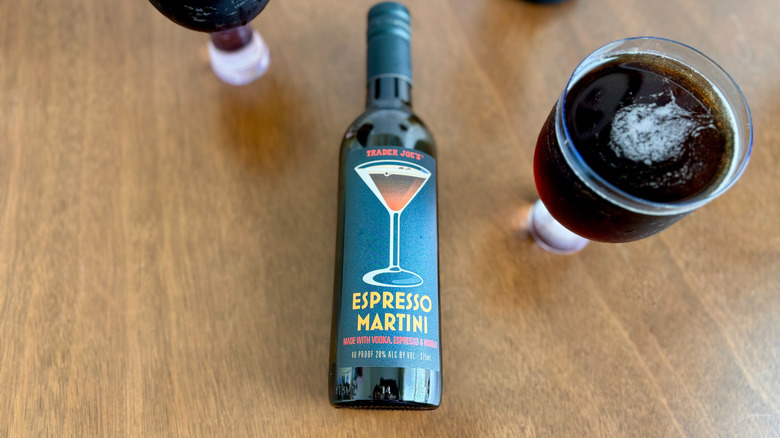Trader Joe's Bottled Espresso Martini Vs Homemade: TJ's Can't Compete
Trader Joe's may be better known for its snacks and food items, but any loyal shopper knows that most stores are super stocked in the booze department, too. Whether you like beer, wine, or spirits, Trader Joe's has beverages to suit all tastes, and the store occasionally even has premade cocktails, like its Everything but the Bartender canned margaritas or Secco wine lineup.
The latest and greatest premade cocktail to enter the TJ-sphere is none other than a bottled espresso martini, a sleek concoction of vodka, espresso, and vanilla. Canned espresso martinis are nothing new, but Trader Joe's bottled version of the cocktail is nothing short of intriguing. Espresso martinis have also become generally very popular in recent years, but most of us save the sipping experience for visits to the bar to get the freshest version possible (and perhaps because not everyone has an espresso machine at home).
Needless to say, Trader Joe's bottled espresso martini opens up an alluring door into the world of accessible cocktails, but one big question hovers over any excitement: Is it any good? I've purchased TJ's espresso martini and put it to the taste test, and for an even more accurate assessment, I compared it to a homemade espresso martini to see if the bottled version is worth the hype.
What is Trader Joe's bottled espresso martini?
Before diving into the all-important taste test, let's establish exactly what product we're looking at here. Obviously, the product in question is an espresso martini, and according to the packaging, it includes vodka, espresso, and vanilla — the first two ingredients are absolutely crucial to an espresso martini, but the last one is a more choice inclusion on TJ's part. There isn't any more info on the back of the bottle about any other ingredients that might be in the cocktail (like some sort of coffee liqueur, which is also pretty crucial to a classic espresso martini), so as far as I can tell, vodka is the only liquor at play here.
The cocktail itself comes in a 375-milliliter wine bottle — for reference, that's half the size of a typical wine bottle you might see at the store. The bottle also boosts 20% alcohol by volume, which is pretty substantial as far as boozy drinks are concerned, so before even tasting it, I knew that the alcohol flavor would be pretty prevalent. Finally, according to the packaging on the back, each bottle is meant to be good for about four drinks or servings, which would end up making for relatively small pours (about 3 ounces).
How much does a bottle cost, and where can you find one?
Since this is a Trader Joe's product, you should be able to find this bottled espresso martini at your local Trader Joe's. In my store, the display of bottles was in the alcohol section, near the spirits as opposed to the wine or beer, but this may vary depending on how your store is set up. This is a limited-time product, and though Trader Joe's doesn't specify just how limited it is, you'd be wise to pick up a bottle sooner rather than later should you be interested in trying it out.
As for price, one 375-milliliter bottle cost me $9.99 before tax. Though the price did seem a bit steep considering how small the bottle is, this is ultimately a much cheaper espresso martini than what you'd likely find at a bar. Also, again, there are supposed to be about four servings in a bottle (probably more like two if you enjoy a heavier pour), so one single bottle stretches farther than it may initially seem.
Taste test
Since my bottle wasn't previously chilled, I followed the suggestion on the label and shook the martini in a cocktail shaker with some ice. In doing so, not only was I attempting to chill the drink (which was a success), but I was also trying to achieve that foamy top that's pretty common with espresso martinis. Needless to say, the foam was not a success. Other than lacking a strong foamy head, TJ's espresso martini looked pretty much how I expected once I poured it into a glass. (Since I don't have coupe or martini glasses, I used a wine glass instead.)
The first sip was a pretty good one, and the drink definitely had some key characteristics of an espresso martini. First, I could definitely taste the coffee, along with a notable sweetness that typically comes from the addition of simple syrup. The boozy aftertaste was pretty strong, possibly even a bit too strong for my taste. One thing I wasn't a fan of was how disjointed all of the flavors seemed to be; instead of enjoying a cohesive sip with hints of coffee, sweetness, and vodka, I tasted a lot of coffee right away, then sweetness, then a sort of pungent boozy aftertaste. Overall, I did enjoy the sips that I took, but I certainly wasn't blown away or overly impressed by this product.
How does Trader Joe's espresso martini compare to a homemade espresso martini?
I initially thought Trader Joe's espresso martini was pretty good and perhaps even comparable to a homemade one ... until I actually tasted a freshly made espresso martini. Drinking the two back-to-back really put into perspective just how good a homemade espresso martini is, and perhaps more importantly, just how lackluster the Trader Joe's one was. For starters, the homemade one just simply looked so much better than the TJ's one — for context, the TJ's espresso martini is on the left in the picture above, and the homemade one, with a foamy head, is on the right.
Flavor is the most important factor here, and the flavor of the homemade espresso martini really was exceptionally better. I don't think I would have realized how watered down the Trader Joe's espresso martini tasted had I not directly followed it up with a homemade one. The homemade espresso martini was bursting with rich espresso, subtly sweet Kahlua, and just the perfect bite of vodka finish; the TJ's one had these elements to an extent, but not in nearly a comparably tasty way. Plus, the homemade one had that notable foamy head, and the drink itself had a certain creamy richness to it despite not actually containing any cream or milk — something that the Trader Joe's version was lacking big-time.
Trader Joe's espresso martini isn't worth the hype
After trying Trader Joe's bottled espresso martini alongside a homemade one, I can safely say that the TJ's one certainly isn't worth the hype. Now, that's not to say this premade cocktail was particularly horrible or unpalatable; instead, it simply can't live up to a homemade espresso martini. In the Trader Joe's version, the flavors just weren't nearly as rich or cohesive as they were in the homemade version. Plus, the alcohol taste was a bit harsh in the TJ's cocktail, whereas any boozy flavor in the homemade one felt well balanced.
Considering that this product can only be found at Trader Joe's, I also would argue that it's not worth the drive to your nearest location just to grab a bottle. The only occasion I could see this product being worth it is if you really want to serve espresso martinis at your dinner party, but you don't want to invest in the separate components that would make up a homemade one. Even then, you'd be serving a pretty lackluster cocktail at your party, albeit one that would no doubt save you the hassle of buying vodka, coffee liqueur, and perhaps even the means to make espresso, should you not have it all available at home. Ultimately, the flavor of Trader Joe's espresso martini wasn't terrible, but it didn't leave a lasting impression on its own, nor was it good enough to compare to the real deal.
Methodology
Trying out Trader Joe's bottled espresso martini was as simple as purchasing a bottle and giving it a taste, but to get the full picture, it felt crucial to prepare the drink alongside a homemade espresso martini to compare and contrast. Also, to be fair, I shook TJ's espresso martini in a cocktail shaker with ice so that it would be chilled, just like I did with the homemade version.
Speaking of the homemade version, I followed this recipe for a classic espresso martini cocktail, but I doubled the portions so that it would fill up my glass in a visibly comparable way to the TJ's version. The recipe called for plain vodka, Kahlua, espresso, and simple syrup — a classic, bare-bones recipe that yielded a really delicious cocktail, despite requiring so few ingredients. I also shook the cocktails for the same amount of time in the shaker — about 20 seconds each — trying to get a foamy head on both. The Trader Joe's one ultimately didn't foam up, but the homemade one did. Finally, I tasted the Trader Joe's one on its own initially, and then I sipped it alongside the homemade one to compare flavor profiles and truly determine which one was better.
